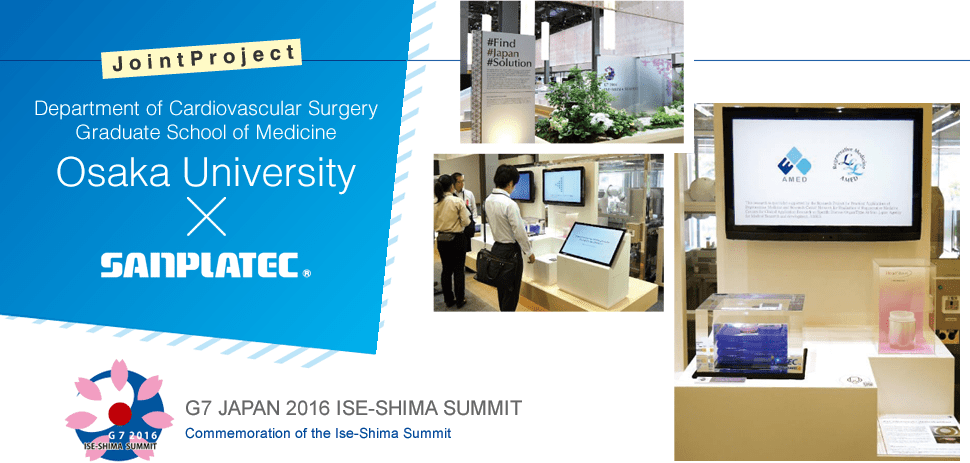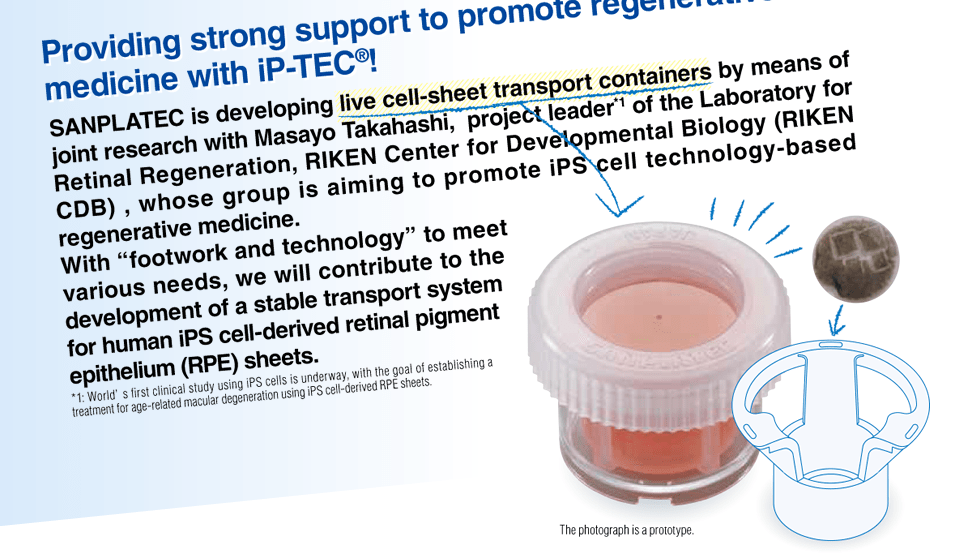
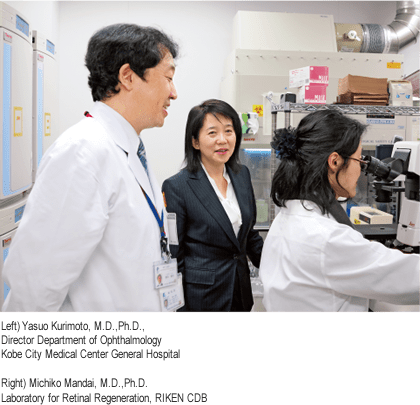
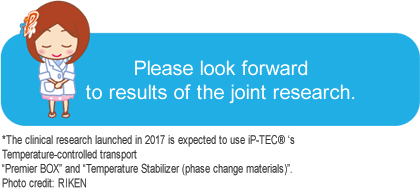
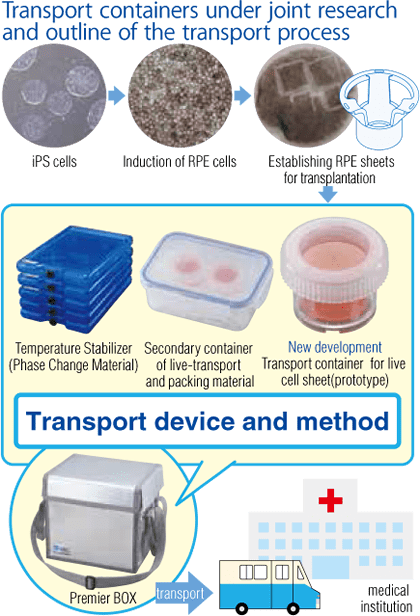
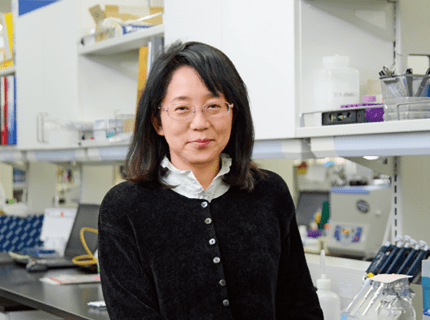
Masayo Takahashi, M.D.,Ph.D.
Project Leader
Laboratory for Retinal Regeneration.
RIKEN Center for Developmental Biology
We place a high level of trust in such an attitude.
In order to make regenerative medicine commercially viable and widespread, emphasis is often placed on “creating of the cells.”
However, “safely transporting the cells” is also a vital task.
Unfortunately, cell preservation and transport are not topics that receive a lot of attention in basic research, which has resulted in the delay of research and development in this area.
As part of our efforts to realize regenerative medicine through clinical research, we are collaborating with Sanplatec to address issues with cell transport.
Addressing the needs faced on-site in the laboratory with good footwork seems easy yet difficult.
We hope that this endeavor will serve as an example of an industry-academia collaboration, as well as an impetus to the realization of regenerative medicine.
I like “Platine” because it is a product full of new ideas. I would like to continue supporting it.
I first met Dr.Takahashi in January, 2016 when she consulted us regarding “a method for safely transporting RPE sheets to hospitals.”
Along with Naoshi Koide, a research fellow in the Laboratory for Retinal Regeneration working on this project we held discussions to share information from the basics of what are important factors in transporting cells to how we could address the needs thereof.
These discussions led us to identify “temperature” and “vibration” as vital parameters for transporting cells.
To address temperature parameters evaluations were conducted under a temperature-monitored environment using “iP-TEC® Premier Box”, “iP-TEC® Temperature Stabilizer” and RPE sheet.
Our evaluations revealed that iP-TEC was exceptional for maintaining tenmperature stability, keeping the RPE sheet in a good condition over an extended period of time outside the incubator.
Its performance was also verified in the transport tests conducted multiple times afterward.
For addressing vibration during transport, we also held many discussions on how to transport the RPE sheets without damaging them. And from the information provided by Mr.Koide it was concluded that currently available containers could not address their needs, leading us to join hands in developing a dedicated container for this purpose.
SANPLATEC was responsible for the original plan, design and trial production and repeated evaluations and improvements were made in cooperation with Mr.Koide.
These ef forts have resulted in the development of a groundbreaking live transport container (prototype) for cell sheets that keeps them intact without damage.
“Supporting the realization of regenerative medicine.”
This fulfilling and joyous joint research project will continue.

Junichi Kuwabara
Senior Manager, Planning
and Development Department
SANPLATEC CORPORATION

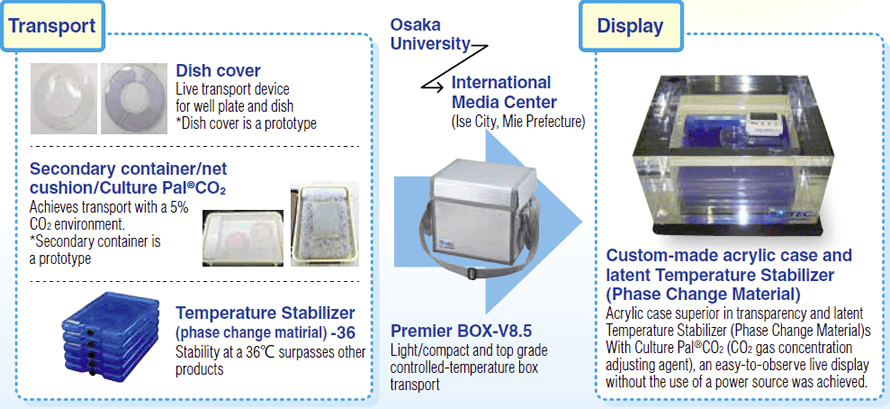
In order to make regenerative treatment technology a part of general medicine, a transport system ensuring stable quality, from the cell culture and processing facility to the transplantation facility, is indispensable. In particular, if the product is a homemade cell product or a custom-made product, it is irreplaceable and extremely rare, requiring a more stringent transport process management. The method of transporting regenerative medical products which are sensitive to environmental changes varies according to the product environment temperature, form, transport method and time allowance for the transport. Therefore, there is a need for a system which can flexibly address various transport conditions, and there is great anticipation toward the development of technology which can meet such a need.
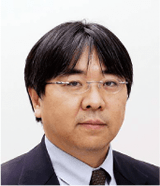
Department of Cardiovascular Surgery Graduate School of Medicine Osaka University
- Q. Please tell us about the background of this display.
-
The purpose was to publicize to various countries abroad, the field of life science which the Japanese government is promoting, in particular the innovative nature of regenerative medicine. However, it was the first time to have a live myocardial sheet display. At first, we did not know the restrictions of the exhibition hall, and we could not obtain the requirement specifications needed for the mission.
- Q. Why did you choose us as your partner?
-
As an image, we wanted to have a simple system which did not require the use of electricity or control device. At that time, we heard that SANPLATEC can provide custom-made products and that you were engaged in a trial production of open-type containers with iPS Portal Inc. We thought that you would have an understanding toward our research and mission. There are other types of Temperature Stabilizer (Phase Change Material) and transport containers; however, it is important to think of what method is best in terms of the characteristics of the “object being transported.” SANPLATEC creates products with emphasis on this factor. In addition, the proposal that we received which enabled having a “display with no power source” with Temperature Stabilizer (Phase Change Material) and acrylic processing technology was a contributing factor as well.
- Q.So you evaluated our customized support andproposal.
-
That’s right. The exhibition spanned over 5 days, and before the start of the exhibition, you helped us simulate at what timing in the Temperature Stabilizer (Phase Change Material) require changing and adjusting, and what equipment is required in the adjustment, etc. Before the requirement specifications were determined, you gave us comprehensive advice.
- Q. Could you tell us what we can do to be of further assistance?
-
Regarding the quality retention of the transported cell sheets, there is the issue of degeneration from the time of delivery to transplantation. In particular, what should be the temperature range during transport? Preparation of variations in transport temperatures will further be required. We look forward to developments in this area as well.
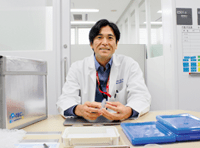
Associate Professor
Department of Translational Cell Therapy
Osaka University Graduated School of Medicine
Medical Center for Translational Research,
Osaka University Hospital



